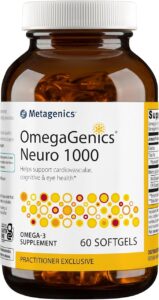A parent left a comment on one of my other fish oil videos, and they asked me to review OmegaGenics Neuro 1000. These are different than the other fish oils I reviewed and a bit more advanced.
There’s lots of fish oil on the market. Before taking any supplements, it’s important to know what you want to target. I don’t know anything about the parent that left the comment. I don’t know where they are in the autism journey. I don’t know what root cause medical problems they’ve addressed. I don’t know what testing they have done. I don’t know what is remaining to address for them. I don’t even know what diet the child is eating. However, the product they asked me to review is very different than the other fish oils that I reviewed.
Types of fatty acids in fish oils
Most fish oils have two kinds of omega-3 fatty acids as ingredients. (As a side note, Equazen, that’s another product that I reviewed, has three types.) For the most part, most common fish oil supplements have two types of omega-3s, and that is
- DHA and
- EPA
Now, there’s lots of chemistry that we can get into, but let’s not complicate an already complicated issue.
Ratio of fatty acids
Many omega-3 fatty acid products have a ratio of EPA:DHA of 3:2 or 2:1, meaning that there is more EPA than DHA in the product.
There’s research that shows DHA is superior in certain aspects of biology in our body, and that in some specific instances, more DHA than EPA should be considered.
What aspects?
A simple way to think about DHA is DHA is utilized more in the top half of our body, and EPA is utilized more in the bottom half of our body.
DHA is needed in fatty areas of our body that require speed. So think about your eyes, your heart, and your brain. So a product with a higher amount of DHA might be a better choice for people with neurological challenges as the main challenge that they’re focusing on.
EPA circulates to support a healthy immune system response. It may be a better product choice for people with general inflammation – aches and pains and swelling, things like that.
Neuro 1000
It comes in a glass container. Let’s look at the label.
Ingredients
The fish oil comes from anchovy, calamari, sardine, and mackerel. It doesn’t say whether it’s wild-caught, though. I’m assuming it’s farm-raised. That’s not ideal. And some fish oils do come from the wild. This one is not listed as such. This does have a natural lemon flavor and a small amount of rosemary extract and antioxidants. And that’s mainly to keep the fish oils from turning rancid. Which is pretty important.
EPA is 250 milligrams. That’s decent. DHA is 750 milligrams, and that is significantly higher than other brands on the market. Remember, this is targeting neuro. So it’s going to have that higher ratio of DHA versus EPA. That’s what makes this product different than other fish oils out there.
Size and taste
They are large fish oils, your traditional big-size soft gel pills to swallow. They’re pretty big. I’ve taken several over a couple of days, and there’s a slight fishy aftertaste, maybe 15 minutes or so after consuming it. Just slightly. Nothing ridiculous or off-putting, but it definitely is there.
Opt or Drop
All right, is this an opt or a drop? Neuro 1000 is definitely an opt – when you get very specific about inflammation. You’ve hopefully already resolved different root causes of inflammation, and if it seems like neuroinflammation is a remaining issue, then this is definitely a logical option. It’s good that there’s still EPA and DHA in this product. It’s a pretty clean product and a great manufacturer, so definitely an opt. However, this would more than likely not be a good choice as an initial fish oil option. This is for when you are getting very specific and targeted about academics and focus.







